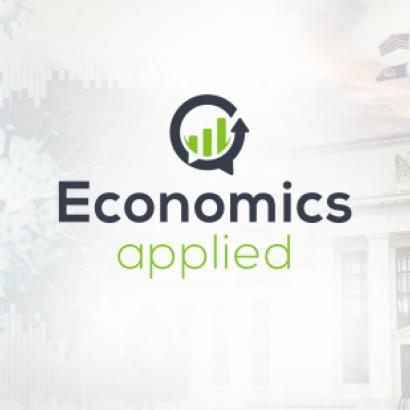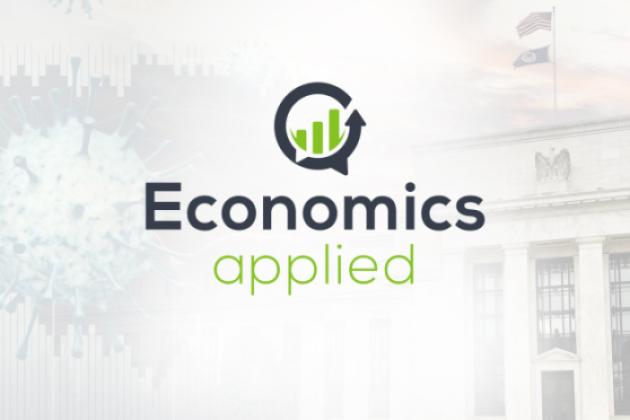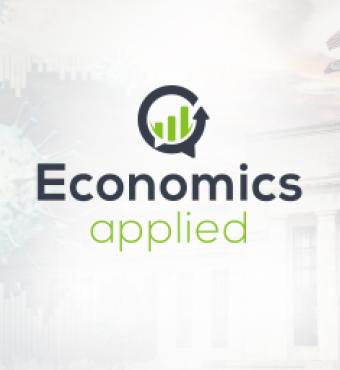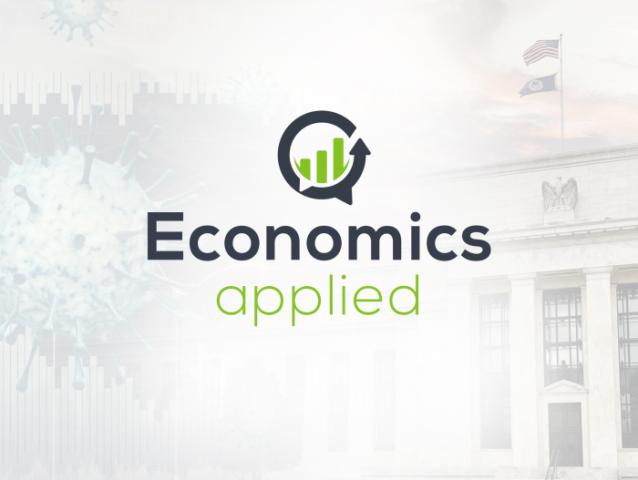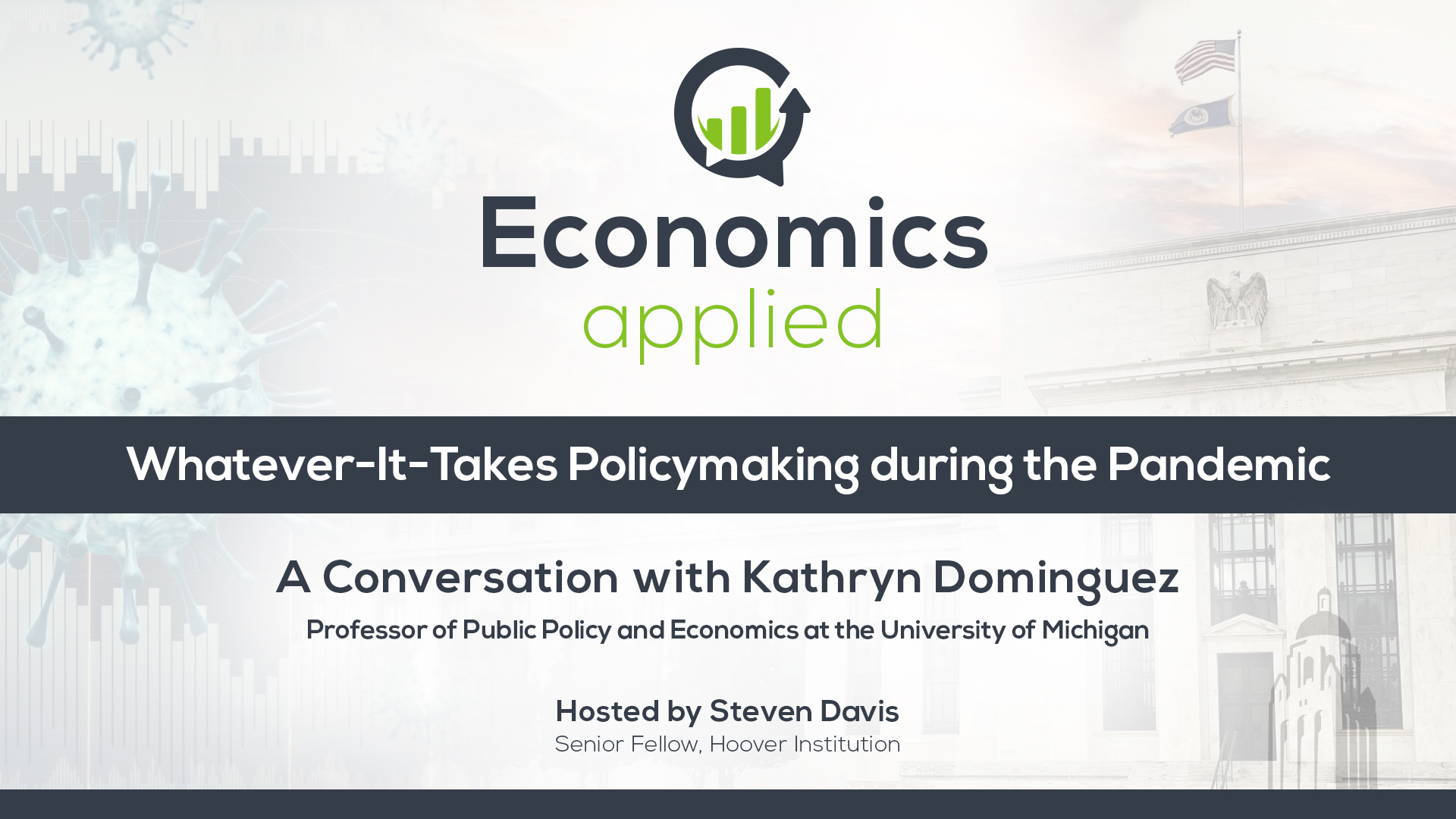Central banks responded to the COVID-19 pandemic with large-scale purchases of bonds, commercial paper, and other financial assets. In some cases, central banks announced “open-ended” programs, with no explicit limits on the scale or duration of asset purchases. Did these open-ended interventions have larger effects on interest rates? On exchange rates? Is this type of purposeful policy vagueness useful in the conduct of monetary policy? If so, why? And when? Join Steven Davis and guest Kathryn Dominguez as they discuss these issues and consider the wisdom of “open-endedness” in central bank policy pronouncements.
To view the full transcript of this episode, read below:
Steven Davis: [00:00:00] Central banks around the world responded to the COVID 19 pandemic with large scale purchases of financial assets. Government bonds, mortgage backed securities, commercial paper, corporate bonds, and even stocks. In some cases, central banks characterized these asset purchase programs as open ended in an effort to And here I'm quoting our guest to shock and awe market participants and restore confidence in financial markets.
Today's show considers the impact and the wisdom of open endedness or whatever it takes. In central bank policy pronouncements and actions
Welcome to economics applied a podcast sponsored by the hoover institution. My name is Steven Davis Senior fellow at the hoover [00:01:00] institution and host of the show. Our guest today is Kathryn Dominguez She is a professor of public policy and economics at the University of Michigan. She's also taught at Harvard, Princeton, Berkeley, and the London School of Economics.
She has served in consulting and advisory capacities to the Federal Reserve's bank system, the World Bank, the International Monetary Fund, the Bank for International Settlements, and I could go on. In short, she's much in demand. So thank you so much for joining us, Catherine.
Kathryn Dominguez: Oh, I'm delighted to be here, Steve.
Steven Davis: So, we will get to the pandemic and how central banks responded, but I want to lay some groundwork first for our audience, not everybody who's deeply into monetary policy, because it is an esoteric topic for most people. So, perhaps you could start by just sketching for us what the standard monetary policy playbook is in reaction to, you know, Uh, [00:02:00] plain vanilla recession and you know what the logic behind that playbook is just so we can have something to contrast it to.
Kathryn Dominguez: Sure. Um, we haven't had that many plain vanilla recessions lately. Uh, so you have to go back a ways, but normally, uh, the, um, monetary authority in most countries have, uh, mandates that say that they're the main thing that they need to concern themselves is inflation. Um, it's not just about inflation or price stability, but also sometimes there are additional kinds of objectives, including financial market stability and, uh, economic activity.
Kind of, uh, maximizing economic activity. Um, so when, uh, uh, an economy is slowing down, uh, depending very much on the context, uh, often central banks. Along with the fiscal authority tried to stimulate aggregate demand or try to [00:03:00] smooth out, uh, the downturn in the economy, and they do so with a number of different instruments, uh, including, uh, basically providing more, uh, capacity for banks to lend to, to firms and households to try to again, uh, stimulate economic activity.
Um, so normally the, the key variable that they're focused on is the interest rate. And one of the things that we, they would like to do in downturns is to lower the interest so that it's easier for people to borrow. And presumably smooth out the economic circumstances.
Steven Davis: And I guess it's, it's fair to say that, aside from the last two recessions, which were big ones, um, central banks, at least in the advanced economies, typically did that by, uh, buying and selling short term government securities.[00:04:00]
Kathryn Dominguez: That's right. Uh, uh, you know, different, different central banks have done different things. Uh, you need a bond market to be able to do what we, what we typically refer to as open market operations. So not all countries, including many emerging, uh, economies don't have, uh, big bond markets. But if, if a country does have a bond market, that was sort of the, the standard way in which the central bank would kind of increase or decrease the interest rate.
Steven Davis: Okay, and so now take us to the pandemic, and you've already alluded to implicitly the global financial crisis, where central banks felt like their standard playbook was not sufficient. To deal with the with the circumstances at hand. So can you can you say a little bit about why? Why couldn't you just follow the standard playbook?
And I understand that you emphasized the standard playbook differed somewhat across countries, depending on their financial market [00:05:00] depth and so on. But why? Why wasn't the standard response enough?
Kathryn Dominguez: So the pandemic was an unusual for for all policymakers. They everyone was trying to figure out how long is this going to last?
And how exactly our households and firms going to respond? Um, I would say the initial stages. Um, so we're talking early 2020. It was really the financial markets that drew in the central banks. We started to see some really dramatic movements in stock markets. In corporate bond markets, uh, and in sovereign bond markets.
So I'd say the initial impetus for central banks to jump in were, uh, the financial markets and the kind of volatility that we saw, um, there, I don't know how far ahead you want me to get, uh, here on this, but, um, It's now often described as the global dash for cash. There was this [00:06:00] sense that as businesses closed down, that everyone was concerned that financial markets might actually, um, really become unstable.
And so there was a sense of, you want to have something very liquid, um, and so liquid as to actually go down to cash.
Steven Davis: To make sure I understand the time right here. We're talking about February 2020 and early March 2020. Is that right?
Kathryn Dominguez: Exactly. Exactly. Um, and and even in early February. Um, so so there wasn't really any discussion yet of of closing down businesses, but, uh, yields curves in the United States and other countries started to invert.
That's often kind of a signal to markets, uh, that things are, are, uh, Uh, looking, um, problematic, uh, going forward. So I think there was from, from the early months of 2020, well before the actual, uh, closing down [00:07:00] of businesses, a sense that things were, uh, not well. And so central banks, uh, And so they felt that one of the things that they needed to do was stabilize financial markets,
Steven Davis: right
And so, among other things, also stock markets collapsed during this period by 40, 50 percent in some countries and by 30 percent or more in many countries. Pretty much almost all around the world, not every country, but almost all the major economies.
Kathryn Dominguez: These were very dramatic movements. Yes.
Steven Davis: were very dramatic movements, and so if you put yourself in the shoes of policymakers, they see this.
Um, they're aware that often, It's not, it's not perfectly accurate, but big stock market collapses often precede downturns in real economic activity, right?
Kathryn Dominguez: That's right. And again, there hadn't yet been a downturn in economic activity, but these were kind of indicators that there was a lot of uncertainty.
Steven Davis: So that, that put the central banks [00:08:00] on notice. The bad economic times were likely coming, but again, why wasn't so? Why not just the an aggressive response with standard monetary policy instruments or maybe Maybe since the global financial crisis, the notion of standard is, is expanded. It's a much more, it's a much bigger toolbox, but, but central banks apparently, and this is one of the points of your paper, took it upon themselves in many cases to make extraordinary announcements.
And you can maybe get into that too, this, whatever it takes, the open ended character of some of these announcements, they felt compelled in some cases to do more than the standard playbook.
Kathryn Dominguez: That's right. It's also. Good to remember the context interest rates were already very low at the beginning of the pandemic.
Um, so normally, uh, again in a. time period where you think economic activity is slowing down. One of the things you'd like to do is lower interest rates, but interest rates were already very low. And [00:09:00] just as had been done during the great recession, there was a sense that, um, the normal kinds of, uh, uh, open market operations type, uh, of monetary policy just really wouldn't do what you needed to do when interest rates were very low.
Financial markets were so volatile. Um, but it is interesting. Um, uh, starting in March, I think it was March 12th. Uh, actually, there's the Bank of Canada. That was the first, uh, uh, central bank that came out very strongly with, uh, a set of, uh, announcements about the kinds of the assets that they would purchase, um, and, uh, a sense that there was no, uh, Limit in size, uh, and no particular time frame over which they would be doing these, uh, uh, purchases.
So, uh, again, kind of, uh, in our paper, what we describe as the first, whatever it takes moment during this [00:10:00] particular episode where central banks decided to go. In very big and, and, uh, the Bank of Canada was quickly followed by the Federal Reserve Bank. Actually, the Bank of Mexico was one of the early, uh, announcers and the European Central Bank.
And then, uh, many, many other central banks, pretty much every central bank, uh, in succession over the next few weeks.
Steven Davis: Okay. So this was open ended, whatever it takes in two respects, no limits on scale. And at least in the Bank of Canada example, you mentioned. no specified duration, no, no, no, no specified end date.
Kathryn Dominguez: That's right. And, and that is quite different than what we have seen in the past, where typically central banks are very transparent or have been actually in the last, say, 20 years of exactly what's the facility, how much will they be spending over what time period, what kinds of eligible assets, very, very clear.[00:11:00]
guidance to the market about exactly what they're doing. Uh, this was kind of we're, we're starting off with sovereign bonds. We might be, uh, actually including other kinds of assets as we go forward. So again, um, uh, somewhat ambiguous, uh, but the ambiguous in the Um, maybe even bigger than we are currently saying, uh, rather than, uh, the much more kind of, uh, typically very clear, transparent, uh, kinds of statements that, that we're used to now and we were used to before this time period.
Steven Davis: So I want to, I want to come back to this, um, deliberate ambiguity aspect of these policies. It's really important, but let's, let's do that after you've kind of described what you found. And how you went about figuring out or assessing the effects of these, whatever it takes type policies. So just lay that out for us, give us a [00:12:00] sense, because it's a, it's a challenging, uh, inference.
question to figure out what these things, how they, how they actually mattered, if they mattered, because many, many other things are happening at the same time. So give us your, give us an explanation of how you went about this exercise.
Kathryn Dominguez: Okay, sure. And let me, let me just backtrack for a second and say, this is coauthored work with Andrea Foskey, who is a graduate student at the University of Michigan, uh, about to get his PhD and go off to the Bank of Italy.
Steven Davis: Wonderful.
Kathryn Dominguez: Yeah. Uh, and, um, we, uh, start with a, um, uh, spreadsheet. We started with a spreadsheet of all the announcements that central banks made over this time period, which includes 23 central banks. And I should say we started off with the idea that we didn't want to look at one central bank. We didn't want to just look at the Federal Reserve.
There had been prior to our study, and there have been since, many kind of [00:13:00] individual central bank studies, but our view was, let's look overall at the whole panel of central banks that made announcements during this time period. And I also want to emphasize the word announcement. So we're looking at announcement effects, not the actual results.
Actual purchases of these assets that they are announcing that they're about to purchase. So we are looking at the, uh, financial market reaction. And in the case of this paper, we're looking at both exchange rate and, uh, Mostly 10 year yields on on sovereign bonds, and we're looking to see how those asset prices move at the time of the announcement and as you suggest, there's there's a difficulty because the central bank is most likely to make this announcement when things are not going very well within the country.
And so [00:14:00] what we try to do is. So, uh, what we do is take into account or control for as many things as we can, as we look at the effect of a particular announcement, which typically, uh, uh, in, in these cases, were not announcements that happened at the usual time, but were kind of outside the sequence of, of announcements that central banks would typically make.
Uh, and we take into account. What announcements were made both by that central bank and other central banks prior to the announcement, we take into account what's going on within the economy, what's going on in terms of covid cases. Uh, what's, uh, going on, uh, in terms of global, uh, uh, COVID cases. So we try to control for as many things as we can that are likely to be driving central bank policy.
Because what we want to try to get at is the [00:15:00] surprise factor. What didn't the financial markets know at the time of this announcement? And then how did they react to this announcement? And again, we're looking across a panel of central banks.
So it's not one central bank, uh, and we're looking across, uh, exchange rates across these various different central banks and their, their own, uh, bond yield, uh, reactions. So, um, again, the, the, um, our, our largest, um, Impact effects tend to be the very first announcement that a central bank makes, and this is very much in keeping, I think, with the context of your question.
One, the first time nobody knew it was coming, and that's likely to be the biggest surprise. Once you've already come out with the, we're going to do whatever it takes, Another whatever it takes announcement or or another just, uh, sort of more traditional announcement about policy is less likely to have a big effect.
And that's exactly what we find. [00:16:00]
Steven Davis: Okay, so you're a few things there. You are resting in part on the forward looking nature of financial markets. Um, so the announcements themselves may the responses to the announcements will, at least to some extent, roll in the expectations that that announcement creates about what the central bank will do in the future.
And just for the, those who aren't aficionado is another. advantage of looking at the financial market responses is financial market data is available at very high frequency and I presume that helps you disentangle the effects of the announcements from other things that are happening in a similar but not exactly the same time frame.
Kathryn Dominguez: That's right. One of the things we grappled with a lot in the paper, we do a lot of different, uh, kind of cuts at this. What should the control be? So we're looking at, um, how does a particular kind of very open ended [00:17:00] announcement, um, uh, what are the impacts of that relative to either no announcement, or what we’ll call traditional or size limited announcements.
So we're looking at how did these things differ both from situations where no announcements were made and situations in which sort of more traditional announcements were made in both cases to try to understand how much. In addition to what we normally expect to see when a central bank comes and says that they're going to, uh, try to, uh, uh, increase aggregate demand through their monetary policy, um, uh, uh, actions, how much bigger were these effects relative to kind of the more traditional kinds of announcements?
Steven Davis: Okay, so you don't want to get into conceptual matter. So let me set it up. You've already made clear that your outcome measure of interest is the yield on long term government bonds in each of these [00:18:00] different countries, I presume, and that's a way to assess the impact on interest rates, okay? But when I think about the case for financial market intervention, It seems to me that the most compelling case is you want to intervene to make sure that financial markets continue to operate in an orderly liquid manner.
That's a little harder to measure directly than yields on government bonds. It's not so obvious. Maybe, maybe you think it is obvious, but it's not so obvious to me that just as a matter of basic economics, that you want to encourage more consumption and investment. In this period, when partly due to government restrictions on economic activity, but also because of people's fears of contagion, there's a very sharp contraction in output.
Okay, so somehow there's, there's less output to go around and it doesn't seem like the ideal time to be encouraging more [00:19:00] consumption, more investment, which other things equal lower interest rates tend to do. So did you settle on the government bond yield because that's the only uniform way to measure the effects?
Is it just too hard to go about? I would think the main goal of these interventions would be, as I said before, let's make sure that financial markets continue to operate in an orderly, liquid manner, which could even happen with some rise in interest rates. A basic economic model with no frictions would say the interest rate ought to go up during this period, not down.
So what's, help us, help us understand how you think about that.
Kathryn Dominguez: Sure. I mean, one thing to note is, uh, after that initial, uh, financial market turbulence that we saw in March, 2020, things did calm down fairly, uh, rapidly. So there, uh, you know, one of the So one of the reasons I think a lot of these announcements were made was, was twofold.
First to actually calm financial [00:20:00] markets, which I think they very successfully did. And then second as this aggregate demand stimulus. Uh It it uh Certainly was the case for many of these central banks. I should also backtrack as central banks came in with these announcements. I think it actually did put a lot of peer pressure on other central banks to basically follow suit because if, uh, A number of central banks are saying, we're going to do whatever it takes.
You look like you're the one central bank who's like letting that their economy, uh, uh, go, go, uh, as, as it will. So there was, I think, a sense of if, if the fed is in there and the European central bank is in there, I should probably be in there as well. Uh, in terms of what kind of, um, outcome variables to look at, again, the exchange rate was one thing that we, that we wanted to look at, um, and we, we do look at in this, um, study.
It, it, uh, it, it. [00:21:00] Gives a little bit less clear, um, uh, a sense of how these announcements were, um, uh, uh, interpreted by financial markets in part because exchange rates are likely to, or we would normally expect a currency to depreciate. When a central bank is is taking on expansionary monetary policy. So if they're saying we're going to do whatever it takes, we're going to be purchasing these assets.
We typically expect the currency to fall in value, but actually, what we find, especially for the US, but for a number of the other advanced economies is the opposite, uh, that in fact, The dollar appreciated relative to many other currencies, as did the euro and a number of the other advanced economy currencies where we saw the currencies depreciate was in the emerging economies.
[00:22:00] And this is kind of, if you step back for a moment, this is not so surprising. This. Uh, I think this kind of comes back to your initial, uh, uh, question about financial market stability. Uh, basically there was a flight to safety during this time period and the dollar was thought to be a safe asset. In fact, I think the Federal Reserve, uh, Announcements of new facilities and these kinds of whatever it takes policies reassured the market that the U.
S. was doing whatever it needed to do in order to keep financial markets stable, and that in turn led to, uh, demand for more dollars and therefore a more appreciated dollar. Um, in fact, I, I, if, if you had asked me what would I expect to see in exchange rates, When something like a pandemic hits, I would have expected a lot more movement than we actually saw.
Uh, and I think part of that is, in fact, because of these [00:23:00] central bank policies, um, and importantly, the fact that everyone was doing it. And the same time. Normally we see big movements in exchange rates because one country is doing one thing and another country is doing another. The fact that all countries are basically doing the same thing at the same time meant that we saw a lot more stability and exchange rates than we normally would have expected with such a large shock.
Uh so I don't I I'm not sure that I've completely answered your question, but I do think that initially most of these announcements were in fact Focused on the idea of financial market stability, many countries then had to follow suit because they too wanted their financial markets to be stable. Um, and then there, there was this sort of, um, ongoing, um, objective of, of potentially stimulated aggregates.
Steven Davis: So there's a lot there to parse. I want to summarize some of it and then probe on one part a little bit further.
Kathryn Dominguez: [00:24:00] Okay.
Steven Davis: So. Exchange, there are benefits of exchange rate stability. That's not the main topic of today. So let's just stipulate that there are benefits to having exchange rate stability. Uh, so, you know, so that was, uh, a benefit of this.
I also understand the argument that if I undertake what looks like a monetary policy easing action and my currency appreciates, that is indirect evidence, at least, that that monetary policy action is having favorable consequences. consequences on perceived financial stability. I think that's also part of what you're saying.
Um, I get that argument. I want to see, I want to ask you directly, do you share my view that the case for financial stability as a reason to intervene during the pandemic, and this would apply mainly in the early phases, Was much more compelling than the case after we'd achieved financial stabilization to [00:25:00] continue putting downward pressure on interest rates as a way to stimulate aggregate demand.
Do you share that view? And if you don't, why don't you share it?
Kathryn Dominguez: I do share your view, although I do also remember there was a lot of uncertainty about how long, uh, the, the COVID pandemic would last and how exactly that was going to, um, affect different, different uh, firms and different kinds of households.
So I, I think there was, um, initially a sense that this might be a fairly short term, uh, pandemic, uh, and then, uh, kind of, uh, uh, sense that this might take longer than we anticipated. So, um, there, there, uh, There could be there could have been multiple reasons for policy as we got more information basically about how long this thing was going to last.
[00:26:00] And, and frankly, also for a lot of countries what the fiscal authority was able to do. Um, you know, not not not all countries put in place. The same fiscal policies. Uh, and, um, that was likely to also have an impact on on how the central banks might might have, uh,
Steven Davis: yeah, I see that argument and you're you're stressing the uncertainty and I think implicit in what you're saying is also the fact that It takes a while for the real side of the economy to respond to monetary policy actions.
So if we could just instantly if the monetary authority could instantly offset shortfalls in aggregate demand, whether you can just wait the Wait for the until the uncertainty resolves, but that's not the world we live in. And so I think that's part of the argument as well. Am I correct?
Kathryn Dominguez: I think so. I mean, 1 of the thing I'll bring up, which obviously has changed dramatically recently, but at the.
Time of the pandemic. Inflation rates were very low [00:27:00] across the world. So the kind of the current focus on inflation simply wasn't there. And, uh, there had been expansionary policy to some degree, pretty much. Throughout the period since the great recession, with no uptick in inflation. So I think the concerns that sort of now we have in retrospect, weren't there at the time that, that this could eventually lead to, uh, what, what we now know as, as, you know, inflation.
Right.
Steven Davis: Well, to be fair, some, some, Some central bank critics were worried about the inflationary consequences of this very loose monetary policy, very tight, very loose fiscal policy in a period in which output had contracted. So, um, but it wasn't the prevailing concern. It wasn't the predominant concern among central banks at the time.
And that's a story for another day, but there's a case to be made. There were two. They [00:28:00] weren't they weren't sufficiently worried about the inflationary consequences of of their actions. Um, okay. So just summarize for us now. What what is it? You found if you kind of hinted at it already, but give us the bottom line results of your empirical investigations.
Kathryn Dominguez: So we find very strong evidence that when countries. actually made these whatever it takes announcements. They had larger impacts, especially on 10 year yields, than did kind of size limited, similar but size limited, announcements. Uh, they, uh, had different kinds of, uh, reactions in the foreign exchange market with advanced economies seeing, uh, Appreciations of their currencies and emerging markets seeing depreciations of their currencies, but largely what we find is that these were, uh, relatively large.
And when I say [00:29:00] relatively relative to other episodes where, uh, announcements were made about, uh, monetary policy, uh, going back to the great recession, these were relatively large, about 50 basis points. Over and above the standard announcement effect. Um, and, uh, we find that for, uh, the the period of time, basically almost all the effects are in 2020.
Steven Davis: Okay, so yeah, you said this earlier that the effects were concentrated at the initial announcement. Yes. Um, in, in early 2020, was there anything? Was there any discernible effect at all? Of whatever it takes type announcements after the initial waves in March 2020 or.
Kathryn Dominguez: Uh, for most countries, it was their first whatever it takes announcement.
Now, some, some countries actually made their first whatever it takes announcements later, Australia was a little bit later to the game than other countries and their, their first, whatever it [00:30:00] takes announcement was also had a large effect. So, uh, we're, we're taking each of the. Um, first announcements and putting them all together and asking what was the effect on these, uh, financial outcome variables.
Um, and we find, you know, strong effects again with most of them, uh, happening in March or April.
Steven Davis: Okay. And okay, got it. And agree. 50 basis points, half a percentage point. That's a, that's a material, a material difference between whatever it takes. and more, more time limited or, or size limited policies. How do you rule out the following, or can you, um, that market participants are reacting to these, whatever it takes, announcements from the central bank because they perceive it correctly or incorrectly to be an indication that the larger government response to the economic and financial consequences of the pandemic.
Will also be in the, in the, in the, whatever it [00:31:00] takes realm, or at least larger than they had previously expected. So not the extent to which the central bank is. closely tied into or reflective of the other aspects of government policymaking differs across countries. But how do I know it's not just, oh, if the central bank's really going to do whatever it takes, I can expect the fiscal authority to do whatever it takes as well.
How do you rule that out?
Kathryn Dominguez: We don't literally rule that out. So, uh, you know, uh, the one thing we do look at is whether or not there were other announcements by, uh, the government's on the day of the central bank announcement. And the answer is largely no. So these were not coordinated announcements. Um, we, we tried to take into account as much as we can of what happened on that day.
So it's. It certainly isn't obvious that there's something else going on on that same day that's actually driving the announcement effect. Um, and [00:32:00] again, part of the reason we have this large panel of central banks is it's hard to believe that all of those central banks, uh, are, are speaking for their government as well as themselves.
Maybe one central bank would have that, but it, it's hard to believe that that would be really what was driving
Steven Davis: it. I agree with that assessment, although I also wonder, so I have the following. You can tell me if this is an incorrect perception. I think, especially in many emerging market economies, whether or not the central bank is formally independent, From the fiscal or financial authority.
It is the case that much of the, uh, economic expertise, macroeconomic expertise, monetary policy expertise inside the country is in the central bank. And so the central bank plays a role as consultant to the rest of the government beyond just what is in their formal mandate. And so you, maybe not for the United States.
But for [00:33:00] some of the countries in your sample, it seems plausible to me, and I want to get your reaction to this, that market participants are viewing the central bank as a barometer of broader thinking among policymakers in the country, and that could be part of the reason why you get these big responses.
Kathryn Dominguez: It definitely could be. I will say this. Uh, most of the emerging markets had not used asset purchase programs in the past. So this was really a break with previous policy. A number of countries actually had to have a Legislative changes that allowed the central banks to actually buy sovereign bonds, which they were not allowed to do.
Brazil was one of those. So, so it was, um, it was a very different kind of policy than than these countries had typically followed in the past that it very much was the case that they. We're doing it often. I think there were some peer pressure effects where, where, um, uh, the, [00:34:00] the Bank of Mexico is one of the first emerging markets out there doing this.
Uh, but a number of central banks, uh, in other emerging markets followed suit, um, whether or not this was kind of, um, Aggregating in some sense, a sense that the country was going to do a lot of stuff, uh, along with this, um, asset purchases. I think it's very possible. I'm not sure that it is a problem, uh, in terms of our results in that, um, I think you can interpret our results as, um, if in fact, during this time period, Central banks wanted to calm financial markets and potentially have an effect on, on their yield curves.
This seems like it was very, um, uh, effective, um, whether or not it was only because of the policy they were announcing or kind of a broader sense for what this, what the country was going to do, um, is harder to disentangle.
Steven Davis: Yeah, that's a good point. You're saying basically, look, even if you [00:35:00] can't be entirely confident about the mechanism or the channel through which the central bank announcement had its effect, For your bottom line result, it still had this effect on, on, on, uh, government bond yields.
So yeah, I take that point. Um, so let, let's go back to something that you hinted at earlier, which I think is, is, it's, it's very interesting, very deep, uh, waters. And that's, you know, we're, let's turn to the role of what this means now for Fed communications more broadly. So there's been, especially since the financial crisis, tremendous interest in forward guidance From central banks and forward guidance has taken many forms.
I think some forms of forward guidance haven't worked out so well and kind of put, you know, taken off the out of the toolbox and put on the shelf, probably not to be used again. Um, this is a kind of forward guidance, but as you stress in your paper and as you indicated earlier in your [00:36:00] remarks, it's not like here's here's our road map.
We're going to go down this, this, this and this. very much. I think you call it constructive ambiguity in your paper. So can you talk about the pros and cons of this form of constructive ambiguity? First, in the context of the pandemic, but then, you know, maybe more broadly, when do central banks want to use constructive ambiguity?
Kathryn Dominguez: I think the the covid pandemic was was possibly a one off. Um, I have to say it was such an unusual event where really, we didn't know. We didn't really know the start the middle or the end. So, in some sense, saying we don't quite know what the We're going to have to do, but we're going to do whatever we need to do, uh, under these very unusual circumstances that that's where kind of fuzzy logic probably works the best in kind of, uh, I think we started off with, you know, your standard vanilla, um, situation [00:37:00] there.
Uh, I could imagine it being very easy to say. We know what's happening. This is what we're doing. And this is why we're doing it. And this is when we'll stop doing it. Um, makes a lot more sense. I mean, one of the kind of worries about this, whatever it takes approach to policymaking, is that it forces central banks into a situation where they'll always have to be kind of escalating even further in sort of, you know, we're going to do even more than whatever it takes to, to, um, Once, once that kind of, uh, benchmark is down, it might then lead to this feeling like you have to be forever saying that we'll do even more than we did before.
So I could imagine, uh, kind of in the post pandemic, uh, time period, central banks wanting to kind of reset the benchmark and be much more clear about, This is the circumstance. This is why we're doing what we're doing. This is when we'll [00:38:00] stop doing what we're doing. To sort of kind of reset, um, away from the kind of really extraordinary policy that was, um, in place and possibly Im important to, to have been put in place at a time when we had so much uncertainty.
Steven Davis: Right. So I want to make a distinction here. So I'm, I'm on the same page as you that a general, whatever it takes approach to any plain vanilla recession, stock market downturn or not that, that's clearly not a good way to go. But there's a broader question of whether constructive ambiguity is, should be, uh, should, should that be an approach that monetary authorities rely on more often.
So it's, it's not so clear to me that. Precise numerical forward guidance has been a success. Um, so you could imagine, um, [00:39:00] moving away from that. That's, that's in the step of, I don't know whether you want to call it constructive ambiguity or Purposeful ambiguity.
Kathryn Dominguez: We're coming back to the rules versus discretion, uh, conversation that monetary economists have been having for years.
But it is, uh, it's a, it ties your hands, obviously, to be, um, uh, super clear about what you're going to do. I think, um, in some cases, it's more stabilizing for financial markets to have a sense for exactly what's going to happen. Uh, it does seem that Chair Powell, uh, is, has tried very hard to be quite clear to financial markets about, um, under what circumstances, uh, things will change and under what circumstances things will stay the same.
So I think there has been more of a movement toward being super clear about what you're doing now. I think where your question is going is how about in the future, and I would [00:40:00] certainly agree with you that kind of tying your hands without really having full information just seems to well is likely to disappoint financial markets, frankly, and and also it's not at all clear that it's going to happen.
It's going to, um, you know, part of the reason to let, uh, markets know in advance about what you're doing is you're trying to get them to move in a way that then makes your own policy, uh, potentially, uh, less Um, it's going to be a lot less large than it might otherwise be. So again, if you can calm financial markets just by saying you're going to do something and then not actually having to do it, uh, that that, um, saves you a lot of fire power.
But, uh, again, um, saying exactly what you're going to do under, uh, future circumstances is probably going to tie your hands in a way that, uh, will not actually achieve
Steven Davis: Yes, and I think that's, you know, that is one [00:41:00] of the big concerns in this area. And some people perceive that the Fed was slow to respond to inflation in 2021 because they were trying to follow through on commitments they'd made or promises they'd made.
Previously under the guise of forward guidance. So that that's one concern that you also alluded to another another concern, which is I don't think you put it in these terms, but if you if you establish precise numerical targets as part of forward guidance looking forward in the future, and then you fail them.
material, you fail to meet them in a material sense, that undermines the Fed's credibility. So I think my sense is the Fed has also lost credibility, uh, in the last three years, not entirely because they failed to meet their, uh, forward guidance criteria, but, but more, more importantly, just because inflation got out of control for a while.
So this is deep waters, and I'm just, the reason I'm emphasizing this is because there's a distinction between To be drawn between constructive [00:42:00] ambiguity in the form of whatever it takes in an episode like the pandemic, and I think you've made a reasonably strong case for that in this episode, but you also said it's a one off.
And, you know, it's not something that we want to make part of the standard, uh, monetary policy playbook, but it, but then there's this tougher issue, which I think the monetary policy makers and central bankers are wrestling with very much these days is, well, how much precision should we have about the guidance we give to mark markets about what we're going to do?
Presumably guidance about what the objectives are. Guidance about and clear transparency about what we're doing now. I think those are pretty, pretty much still a lot of consensus around those, but I don't see a lot of consensus around how much precision we should provide the markets and in what form.
Uh, about what we're going to do in the [00:43:00] future.
Kathryn Dominguez: I agree with you. I mean, there are some emerging markets who have probably tied their hands even more than than say, the Fed. Um, and they probably needed to given given their history. Um, but, uh, you know, for most advanced economies, it's not clear that you buy yourself very much, uh, by by, uh, you know, Tying your hands, and it does seem like the reputational effects are potentially problematic.
Steven Davis: Okay, so any, any other broader lessons you think that we should draw from your research, from what we've learned about this whole episode for monetary policy going forward? It's there.
Kathryn Dominguez: Well, I actually take the results is is kind of an opt in. I'm an optimist, uh, about policy, and it does. I went in not not quite sure what we would find.
Um, uh, just because, you know, I hadn't done the research yet and I. I thought that there would be, [00:44:00] um, some effects. I didn't know that they would be as large as they were. I wasn't sure that all central banks would have had, uh, kind of a similar effect. Um, so I, the optimistic kind of, uh, interpretation here is when central banks really need to do, uh, Uh, I think they were very successful in calming financial markets at a time where you could have imagined things really going south quickly.
I think there were, um, you know, to bring yourself back to March 2020. I think we were all just sort of aghast at what was going on in many financial markets, and we had gone through the financial crisis in 2008. I think a lot of people had this kind of Kind of feeling of, Oh, no, here we go again. And truthfully, uh, the central bank policies were very successful.
Uh, you know, stock markets, bond markets really calm down quite quickly. Uh, and it does [00:45:00] seem like leadership. I I'll put it, uh, before I called it peer pressure, uh, leadership, uh, among the earlier. Central bank actions where they were successful, I think, then let other central banks to realize, Okay, we can do this, too.
Um, so I take it as a very positive example of central banks being able to come in at a moment of potential panic, calm things down. And obviously, there, there have been all kinds of, um, Difficult, um, consequences of of the pandemic, but one of them wasn't a complete collapse of the financial markets, which I don't know that we could have.
Said in advance would would have happened. Um, so I, I take it as very positive signal that in at least this particular circumstance, uh, the approach taken seemed to have been very successful.
Steven Davis: So. You make a very important point. It is [00:46:00] useful to put yourself back in the mindset of, especially March 2020 and in the, at least in the U.
S. and the advanced economies, maybe a little bit later in some other places, you know, there were, there were, there were serious legitimate concerns that things could have been much worse and, uh, the fact that they didn't get Appreciate it. Much worse, I think is a testament in part to the central bank interventions.
I think that part of the central bank response. I I'm on exactly the same page as you belong. Continuation of easy monetary policy. I think that that. The case is much less compelling that that was an appropriate that that was a desirable monetary response, given the way things have played out, or even, you know, whether it seemed desirable in real time, but the early response, yeah, it could have been much worse.
There were legitimate concerns. You can just go back and read the newspapers from that that time period. So I think, in that sense, this was a success. You know, [00:47:00] something else I you you reminded me of something. And I. It's not the topic of your paper, but I just want to put it on the table and see whether you want to comment on it.
And that is a behind the scenes role that the Fed played that was quite important in this period, but also in the global financial crisis are the liquidity facilities that the Fed extended to other leading central banks around the world. Uh, and you know, I think of the Fed as the central bank for central banks.
And I think those facilities and their expansion also Help these other central banks to respond in a way that that, uh, squelched some of the fears of, uh, financial panic. Is that is that a correct assessment? Your view?
Kathryn Dominguez: I totally agree with that. And obviously, the swap lines were, were, uh, hadn't been used before and were put in place and expanded.
But the. FEMA, uh, facilities were, were I think what you're referring to, along with many others, which [00:48:00] basically just provided kind of a, um, a guarantee or insurance that, uh, other central banks would have access to dollar assets. Uh, and I think it really calmed a global markets to know that those facilities were out there and available.
Uh, and, and I think they had a huge impact.
Steven Davis: Okay, so, yeah, so we'll, we'll close, we'll close with this, um, three cheers from both of us for the Fed's early response to the, to the pandemic induced recession and financial, and potential financial panic and turbulence. Well, the verdict's yet to be, yet to be fully in, I think, on their later responses.
That's my view, and I guess that's your view as well?
Kathryn Dominguez: It is, it is. I, I, you know, I, I, I think it's a little unfair, uh, with, with the, with hindsight to, uh, sometimes say, uh, things, uh, because in the moment we might, might've made other choices, but, um, certainly with hindsight, [00:49:00] it seems that not just the Fed, but most central banks continued expansionary policy too long.
Steven Davis: Yeah. Okay. Thanks so much, Catherine. That was a really, uh, illuminating conversation. I really enjoyed it. And, uh, very clear. I hope that, uh, some of your tremendous knowledge and expertise on this subject got transmitted successfully to our audience. I think it did. Thanks so much.
Kathryn Dominguez: Well, thank you. It was great talking with you.
Okay.
Steven Davis: Take care. Bye bye.








